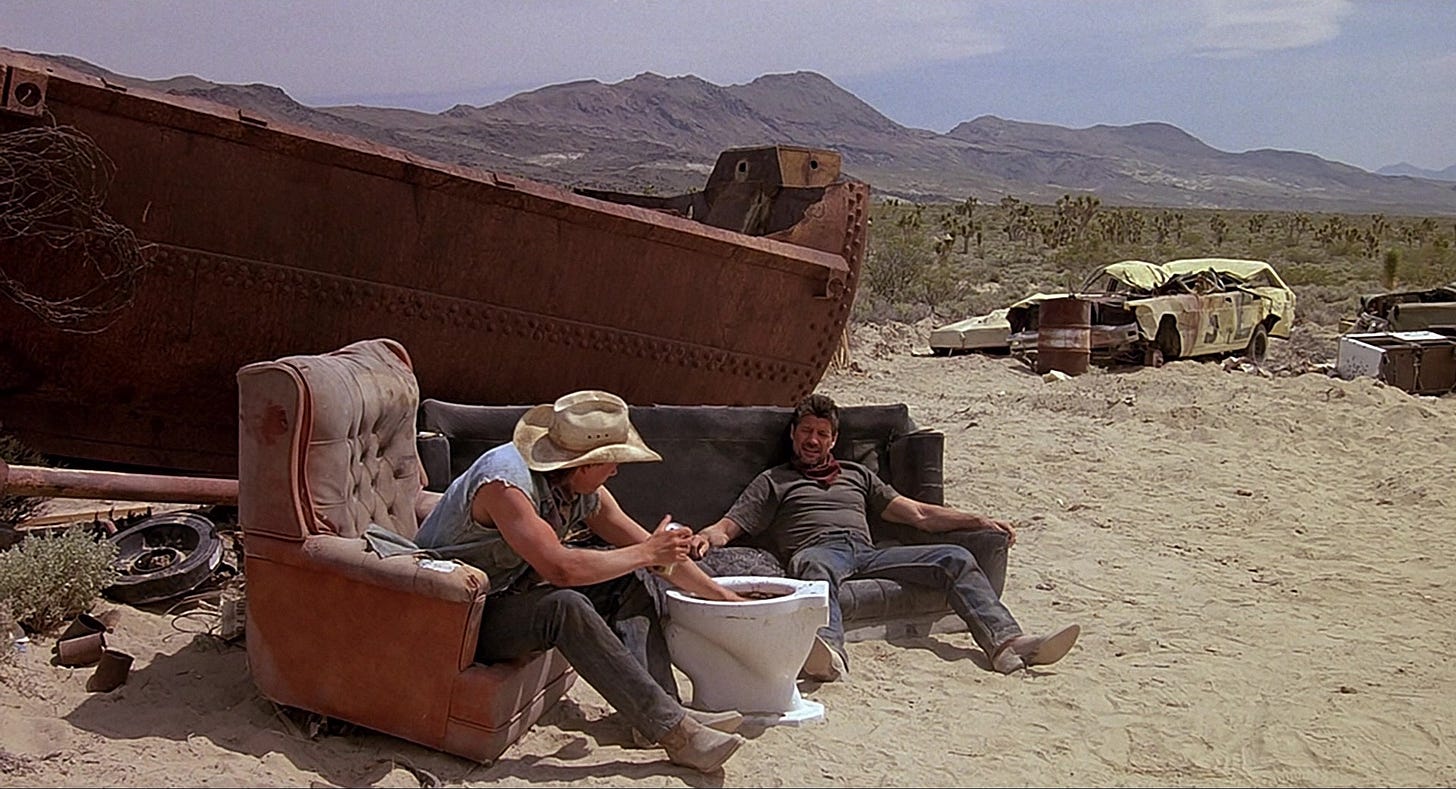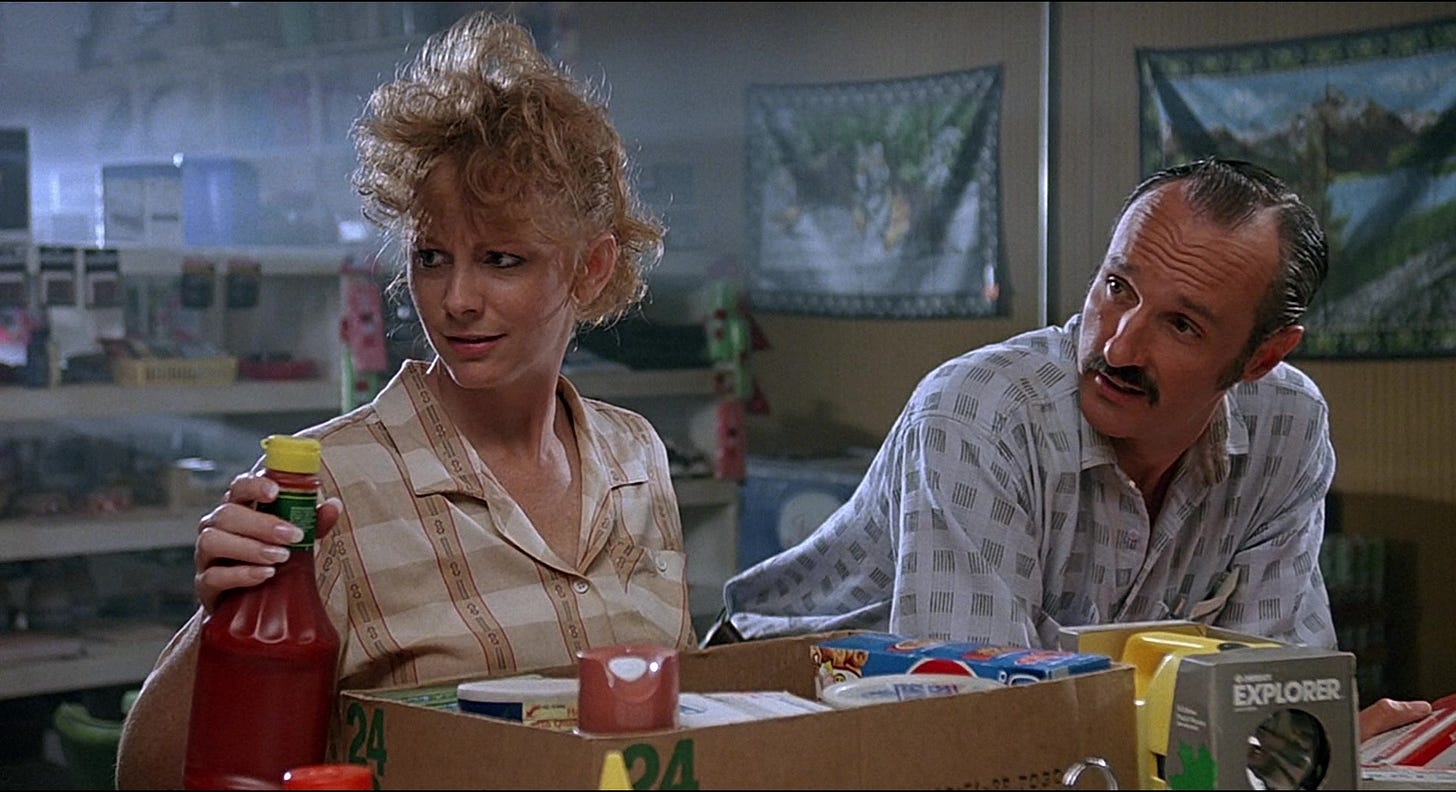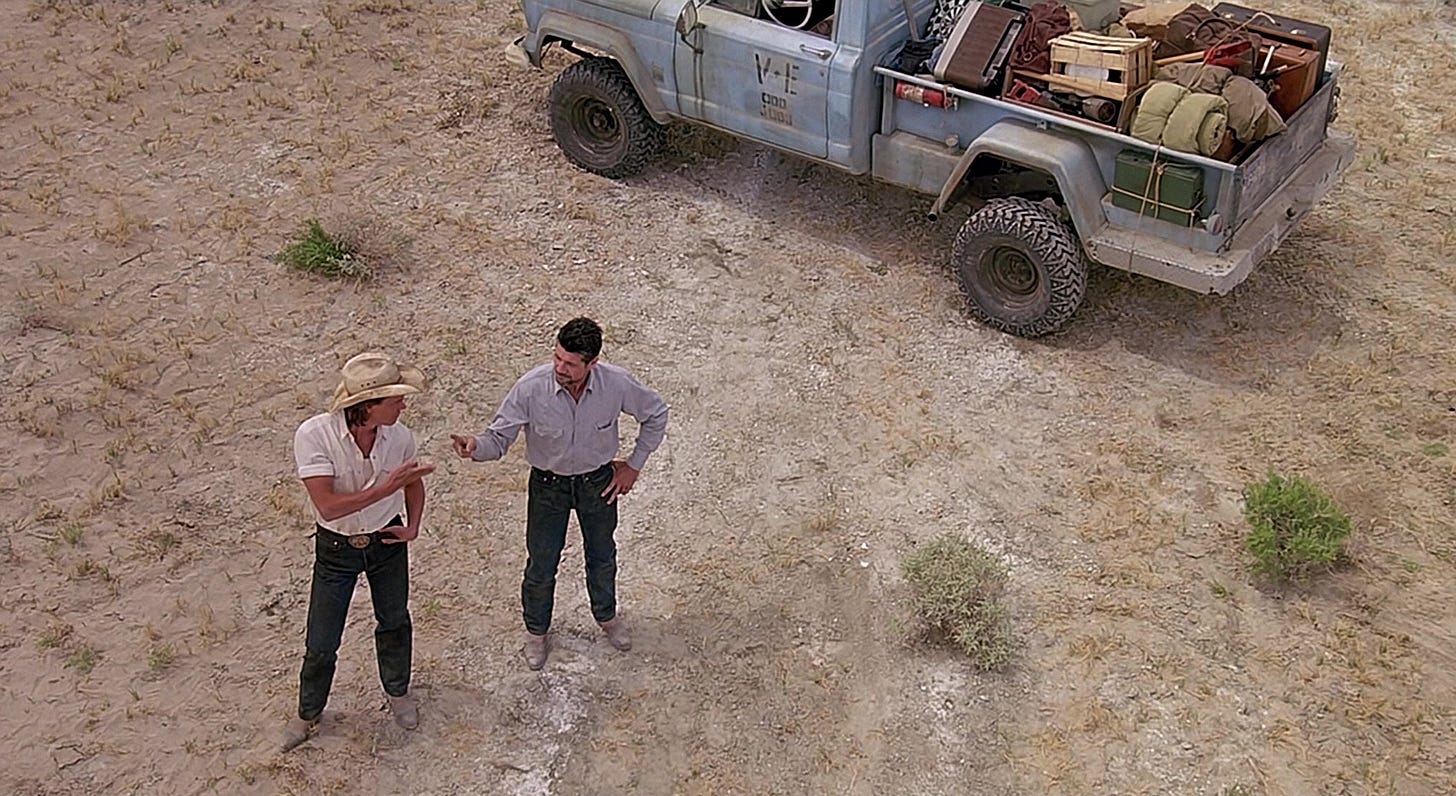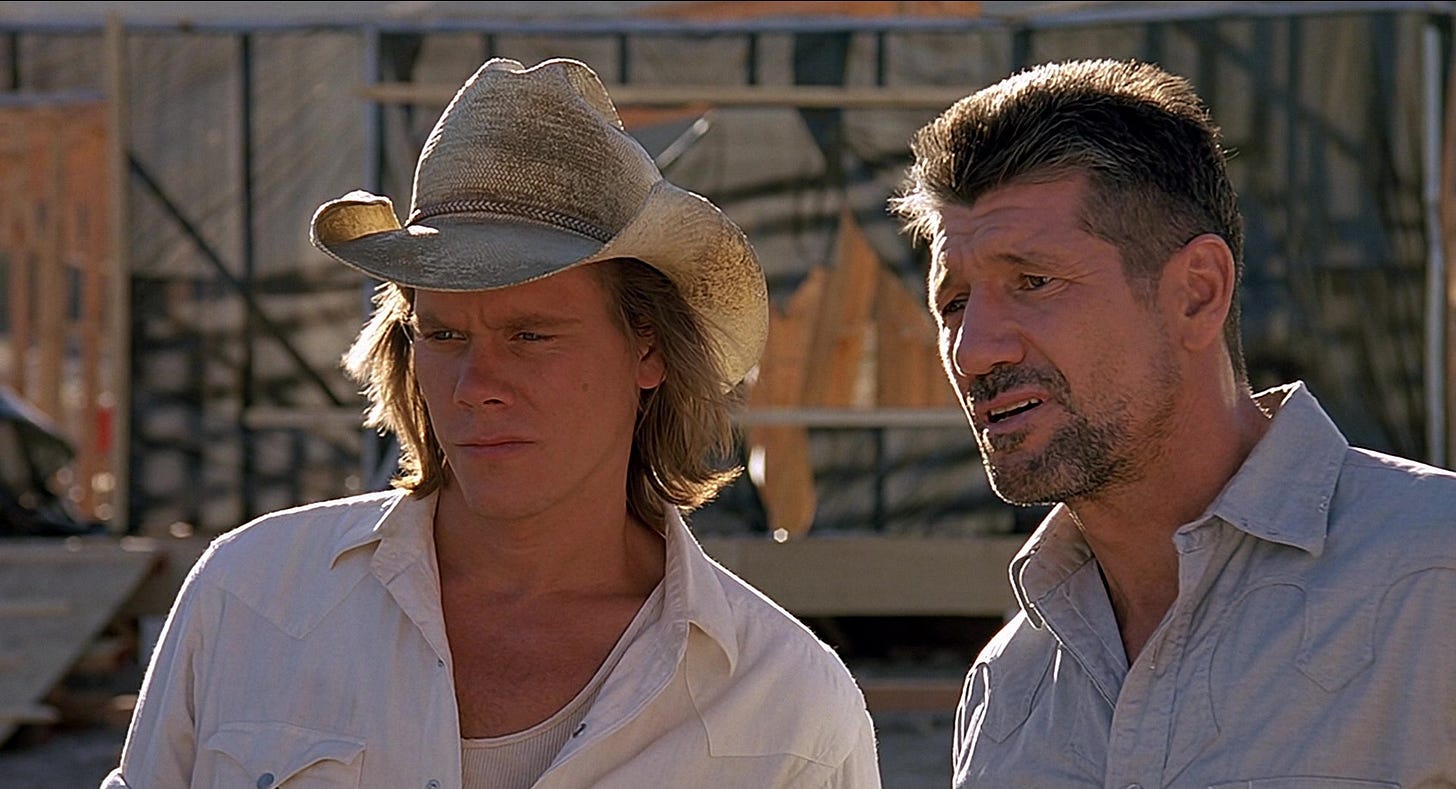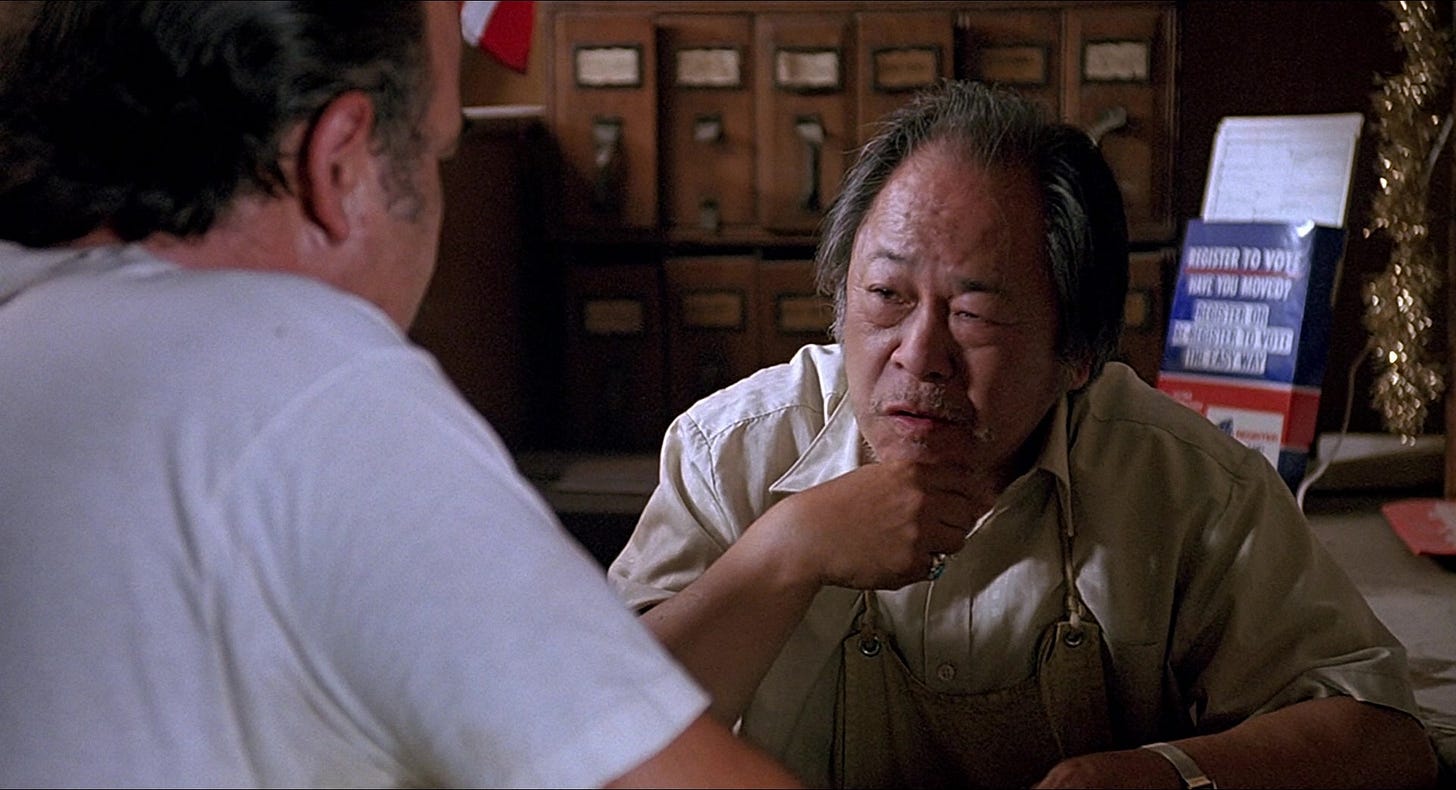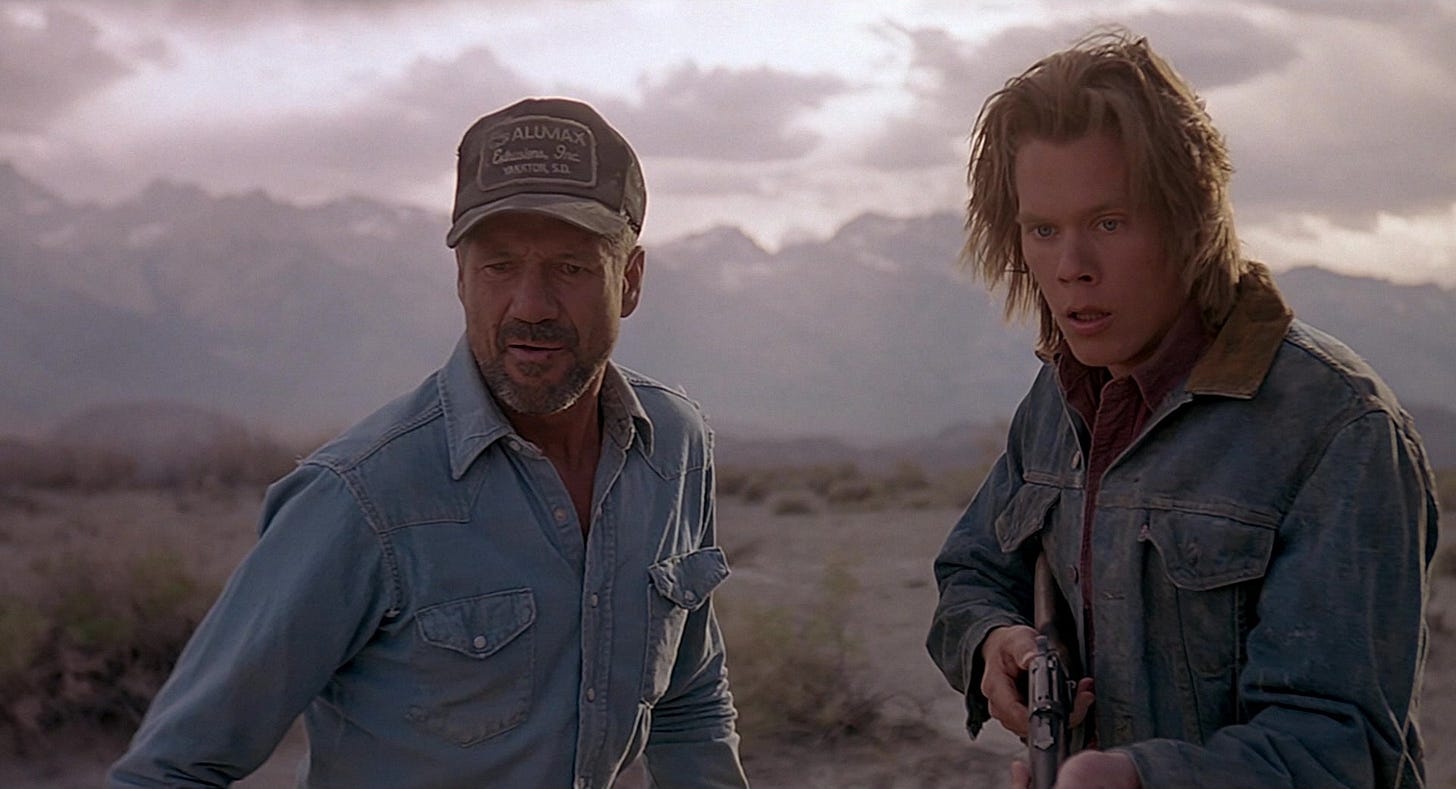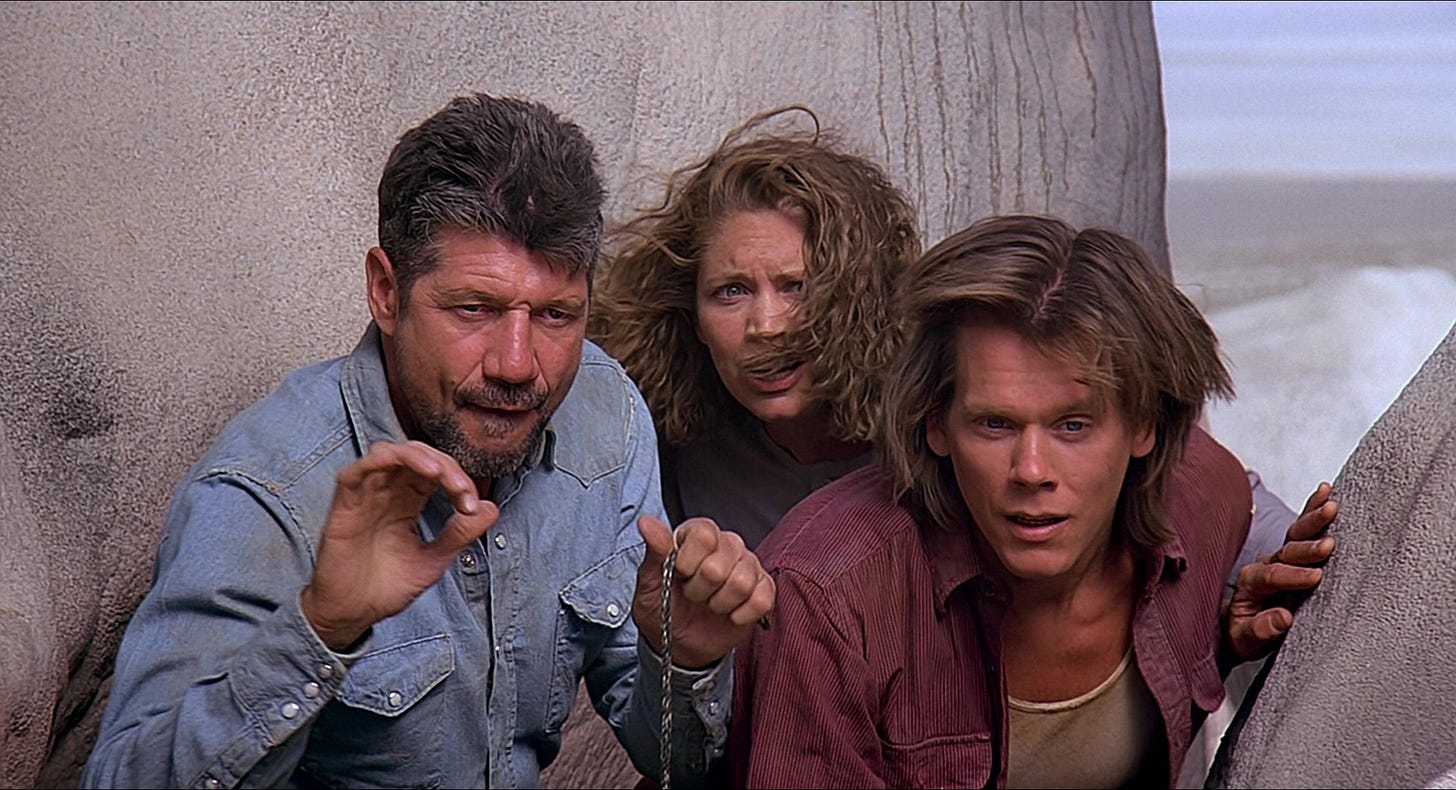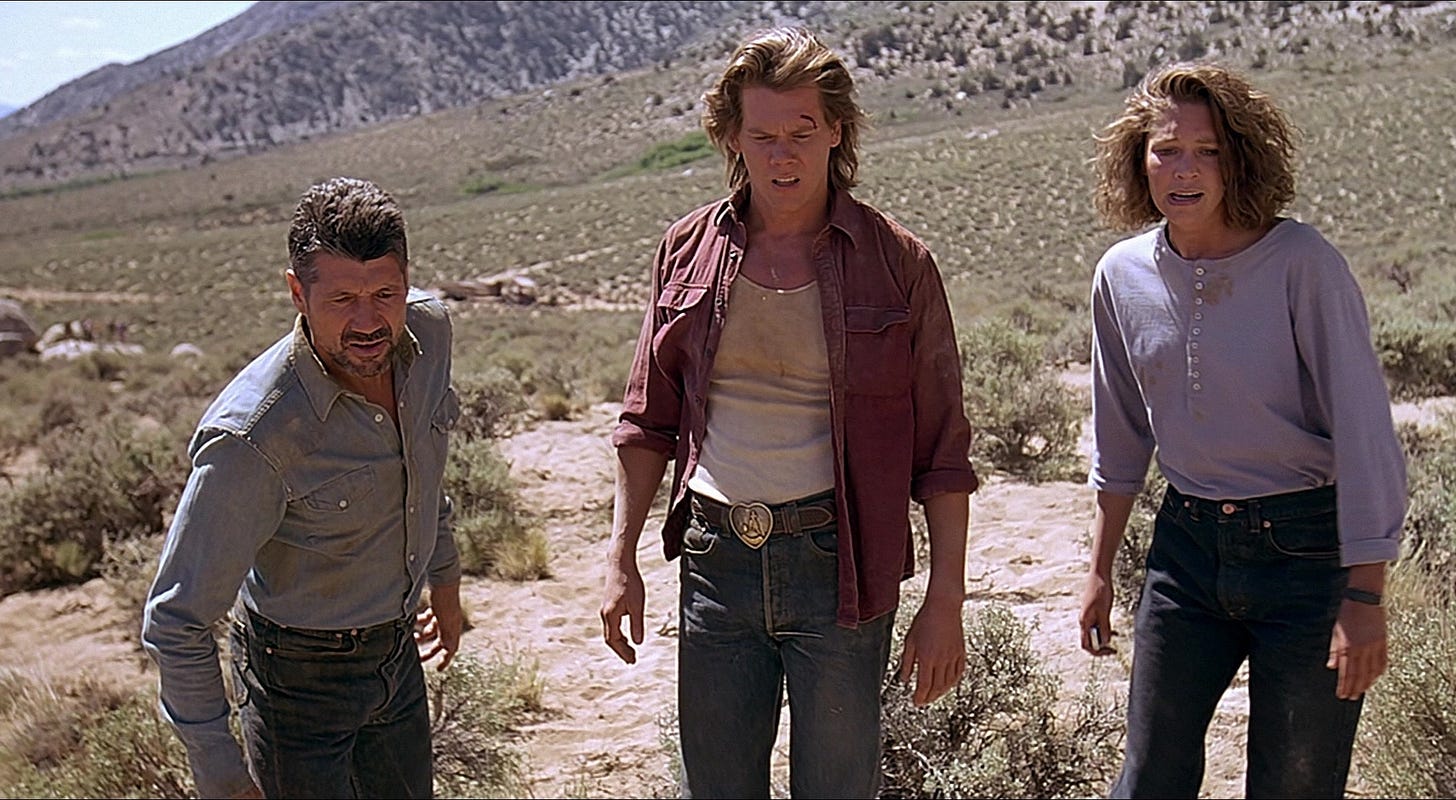In the month of October, Video Days is looking out for scaredy cats, counting down to All Hallows’ Eve with eight horror movies in ascending scariness.
TREMORS (1990) threads a needle between science fiction frights and between comedy that’s based as much on character as physics. Rated PG-13, the filmmakers appeal to both adults and children, including those from either age bracket who don’t enjoy horror movies. Taking place in an outpost of a dozen souls in the Nevada desert, the film uses casting and music to generate a bonafide western sensibility, set in the bright outdoors (with horses and trailers and tractors), sparing the shadowy claustrophobia of most horror films. And it’s entertaining from start to finish.
Brent Maddock & Steven Seth Wilson and Ron Underwood met on the campus of the University of Southern California in the early 1970s. Though growing in prestige–graduating George Lucas, John Milius, Robert Zemeckis & Bob Gale and John Carpenter–the department was housed in a former horse barn constructed during World War I. Maddock, who’d started making movies with his father’s 8mm camera at the age of 10, was a fan of physical comedy–having broken his neck doing a stunt for a student film when he was nineteen–and had earned his BA from Colgate University in New York. S.S. Wilson was born in Oklahoma but grew up all over, attending high school in Hawaii. He was so obsessed with movies–particularly the creature features of stop-motion animation pioneer Ray Harryhausen–that when he enrolled in psychology courses at Penn State, his psychiatrist father told him he should study what he loved: film. Underwood, who’d discovered his ardor for film while a junior high school exchange student in Sri Lanka (then Ceylon), also anticipated becoming a doctor, enrolled for six weeks in pre-med courses at Occidental College before he transferred to USC to study film.
After graduating, Ron Underwood moved to Milwaukee, where his wife was attending dental school. They returned to Los Angeles a couple of years later and Underwood applied to the American Film Institute as a producing fellow. This led to work directing educational and industrial films. Maddock (who’d developed a knack for editing at USC) and Wilson (who had experience in educational filmmaking through a stint in the army) cut and supervised the special effects, respectively, for several of Underwood’s short films. One of them was titled Library Report. Set in the future, it was about a teenager asking her robot to write a term paper for her, which the robot teaches her how to do. Library Report convinced the filmmakers that a feature-length screenplay about a robot, paired with their short, might raise money for a real movie, one they could make themselves, Underwood directing, Maddock editing and Wilson supervising the stop-motion effects. Maddock & Wilson got to work on a script, which they titled Short Circuit.
A guy Maddock had met at an Advanced Screenplay Workshop in the UCLA Extension program and who knew the son of producer David Foster let them know that Foster–a producer of Caveman (1981) and The Thing (1982) — was looking for a script about a robot. Maddock & Wilson passed Short Circuit along and when Foster offered to take it off the market, they garnered interest from three agents to represent the sale. One of the agents was Nancy Roberts, whose background was business administration, and without clients, founded her own talent agency in 1982. Though Maddock & Wilson were older than she imagined reading Short Circuit, Roberts impressed the screenwriters with her read on their script. In May 1985, Roberts negotiated the sale of Short Circuit to David Foster for more than he’d initially offered: $360,000. With little more than educational shorts on his resume, Ron Underwood was passed over as a director in favor of John Badham. Opening May 1986, Short Circuit was a hit, and Maddock & Wilson were commissioned for work on several projects at Amblin Entertainment that would be produced: *batteries not included (1986) and The Land Before Time (1988), as well as a project titled Ghost Boy that Amblin would exit and would be rewritten for Bill Cosby as Ghost Dad (1990).
Complaining to Roberts how little creative control they’d had over their work–which included Short Circuit 2 (1988)–Roberts suggested Maddock & Wilson write another original screenplay, its sale contingent on her attaching them as producers. The screenwriters dug through their files for ideas. Wilson had for a time been contracted at a navy facility in the Mojave Desert as an editor of industrial films, and bouldering in the foothills on weekends when the gunnery ranges were quiet, had sat atop a rock and wondered what would happen if there was a creature underground that had him trapped. Nancy Roberts thought the “monster in the ground” idea–which Wilson had scribbled the title Land Sharks next to–had the most potential. Ron Underwood had, since the sale of Short Circuit, directed a live-action/ stop-motion adaptation of Beverly Cleary’s children’s book The Mouse and the Motorcycle (1986) as an ABC Weekend Special, winning a Peabody Award, as well as directing its sequel, Runaway Ralph (1986). Maddock & Wilson had just enough leverage to attach Underwood as director, and proceeded to develop the story for Land Sharks with him.
After considering Graboids as a title, Maddock & Wilson and Underwood would settle on Beneath Perfection, a play on the name of the isolated town where their action took place: Perfection, Nevada. Their idea led to a pitch, which was passed on by everyone the team delivered it to. Maddock & Wilson and Underwood expanded their pitch to a three or four-page treatment. That was rejected by anyone in a position to commission a screenplay. Despite their track record as screenwriters of several modestly successful science fiction or fantasy pictures, Maddock & Wilson were surprised by how few studio executives knew what to make of Beneath Perfection, realizing how few of them had loved or were even aware of the monster movies by Ray Harryhausen. Roberts compelled Maddock & Wilson to write Beneath Perfection on spec, which they collaborated on despite living twenty miles apart by using CP/M word processors and a dial-up modem. This technology enabled transmission of a 120-page document over the phone lines in an hour and a half, if neither writer received a telephone call, which would terminate the file transfer and force them to start from 0%.
Maddock’s forte was character, with a preference for writing physical comedy, while Wilson was good with story and loved monster pictures and horror pictures. They’d conceived Beneath Perfection as a homage to 1950s science fiction movies, in which radiation, outer space, experimentation or Mother Nature delivered giant, voracious monsters that went on a rampage. It took six months before the duo had a draft that Roberts was able to pry loose from their word processors. She read the piece as a well-balanced mix of horror and comedy, a scary movie with comic relief, but none of them sure whether Beneath Perfection should be sold as comedy/ horror or horror/ comedy. Over the next six months, Maddock & Wilson leaned into the latter, trimming material that made sport of the monstrous and carnivorous worms, or jokes on the part of the characters. Seeking a partner who had a strong hand in genre film, prestige, and with it could nurture a first-time director, Roberts partnered with Gale Ann Hurd, who had achieved all three as producer of The Terminator (1984), and whose company Pacific Western Productions had produced genre pictures in the $10 million budget range.
Roberts had gauged the market–telling Maddock & Wilson that Disney would pass because one of their senior executives hated western motifs–and zeroed in on Jim Jacks, senior VP of production at Universal Pictures, who Roberts believed would appreciate Beneath Perfection. Jacks did, securing approval from the regime of studio chairman Tom Pollock. Universal agreed to acquire and distribute Beneath Perfection as a negative pickup, purchasing the film from Pacific Western upon completion at a production budget just shy of $12 million. By comparison, Gale Ann Hurd’s epic production of The Abyss (1989) had come with a publicized budget of $43–47 million, while a knockoff deep sea monster picture titled Leviathan (1989) had cost between $22–25 million to produce. With Brent Maddock & S.S. Wilson as writers/ producers and Ron Underwood as director, Hurd assumed the role of executive producer and hired a crew. Ginny Nugent, who like Hurd had gotten her start as assistant to Roger Corman, and worked for Hurd as an associate producer on Bad Dreams (1988), was hired as line producer. Director of photography Alexander Gruszynski had lit Bad Dreams. Creature effects designers Alec Gillis and Tom Woodruff Jr. had known Hurd from their days working for Corman on Battle Beyond the Stars (1980) and Stan Winston Studios for The Terminator and Aliens (1986). Gillis and Woodruff had launched their own company, Amalgamated Dynamics Inc., and were waiting on pins and needles for their first feature film commission when Hurd sent them the script for Beneath Perfection.
In their script, Maddock & Wilson had simply described the graboids as burrowing creatures with a mouth that opened like a flower. The special effects industry had yet to witness the breakthrough in digital effects with Jurassic Park (1993) and it fell on AMI to design, build and operate characters that would perform not only in a studio, but desert locations. The makeup effects house built four graboid heads and one thirty-foot body, as well as quarter-scale puppets, which miniature effects artists Robert and Dennis Skotak animated for shots requiring more movement. Kevin Bacon and Fred Ward were cast as Valentine McKee and Earl Bassett, the town handymen who are the first to encounter the graboids and survive. Achieving a career breakthrough starring in Footloose (1984), Bacon had since signed on for the lead in one commercial misfire after another. Quicksilver (1986) was ignored by critics and audiences, White Water Summer (1987) orphaned by the studio, and the release of She’s Having A Baby (1988) held up by eight months, opening to awful reviews and poor attendance. The actor couldn’t help but regard a monster picture as the nadir of his career. Joining Bacon and Ward were Finn Carter (a former cast member of As The World Turns), Michael Gross, Reba McEntire and Victor Wong.
Production designer Ivo Cristante, another veteran of Bad Dreams, spent two months building Perfection near the California town of Lone Pine, a three hour drive from Los Angeles in Owens Valley, on the eastern side of the Sierra Nevada Mountains. Filming commenced in April 1989 on what Hurd had assigned a working title of Dead Silence as placeholder for a better one. For the climax, Cristante constructed a rock formation in Alabama Hills Recreational Area, where films like High Sierra (1940) to Bad Day At Black Rock (1955) had utilized the region’s striking geological formations. Production was not easy. 3,700 feet above sea level, the desert shoot was met with snow on its first day. Overcast skies broke enough for filming to proceed, but costumed in shorts, Finn Carter endured cold weather for the scene where her character monitors a seismograph. Hail, dust and high temperatures would later visit the Lone Pine location. In 1989, the crew’s only connection to the outside world was a radio telephone they had primarily because Bacon’s wife Kyra Sedgwick was expecting their first child. Interiors would be shot at Valencia Studios in Valencia, California, where Bacon was filming an action scene in “Chang’s Market” when a production assistant notified them that Sedgwick was going into labor.
According to S.S. Wilson, when Tom Pollock received a crew jacket for Beneath Perfection, the studio chairman vehemently opposed releasing the movie under that title. While no one has taken credit, the filmmakers would arrive on a title more appropriate for a horror movie: Tremors. Maddock & Wilson, as well as Underwood and Roberts (since credited as the “godmother of Tremors” but uncredited for the original film) had left the origin of the graboids up to the viewer’s imagination, refusing to include a scene that explained where the creatures came from, allowing the characters to debate this among themselves before moving on to more pressing matters. As insurance in case test audiences were confused, Maddock & Wilson drew up a scene in which, like many science fiction films before it, an object from space crashes in the desert and unleashes the graboids. Their department heads hated it so much, this prologue was never shot. Universal was in the process of selling a major stake to Matsushita Group and though Tremors tested well without it, studio executives thought it would be a great idea to introduce the creatures emerging from something the Japanese were on familiar ground with: earthquakes. The filmmakers did shoot a prologue in which the graboids surfaced from a shaker to devour a coyote. Test audiences who’d shown no discomfort for townsfolk being gobbled up drew a line at a coyote being harmed and their feedback convinced the studio to drop the prologue.

Tremors opened January 19, 1990 in 1,472 theaters in the U.S. Critical response leaned negative. Gene Siskel & Roger Ebert split. Siskel admitted there were elements that were great–giant worms realized as credible monsters, Fred Ward’s performance–but couldn’t recommend the picture, finding the other characters uncompelling and only so many tricks for the graboids. Ebert liked it, “just barely” enough to recommend. He cited Bacon, Michael Gross and Reba McEntire (playing a survivalist couple, Bert and Heather Gummer) as all being funny. Ebert did delight in pointing out gaffes, like point-of-view shots from creatures that are supposed to be blind. He also questioned what the graboids had been eating and why there were only four (Siskel also wanted more giant worms, admitting in his negative appraisal that it was all a cute idea). Writing in the New York Times, Vincent Canby dismissed the movie: “Tremors wants to be funny, but it spends too much time winking at the audience. More than anything else, it looks like the sort of movie that might have been put together so that tourists visiting Universal Studios could see a movie being made.”
To the disappointment of everyone from the filmmakers to Kevin Bacon–starring in his fourth box office dud in a row–Tremors was overlooked among hits held over from 1989: Driving Miss Daisy, Born on the Fourth of July, Tango & Cash, The War of the Roses, Steel Magnolias. The horror/ comedy seemed to alienate fans of both and after three weekends, dropped out of the top ten grossing films in the U.S. Ron Underwood blamed Universal for distancing themselves from Tremors due to it being a non-union production (that hadn’t hurt the Friday the 13th franchise acquired and distributed by Paramount Pictures, and doesn’t account for the studio opening Tremors in more theaters than Born on the Fourth of July or Steel Magnolias). Audiences headed back to school or forward into the new year simply didn’t recommend or return to see the movie in theaters. Released on home video in July, the film’s fortunes began to change (ironically, the video market had rendered the educational film market which Underwood, Maddock & Wilson had trained in nearly obsolete by this time). Tremors was a huge seller on videocassette, so much so that Universal Pictures Home Entertainment–which would begin producing straight-to-video sequels to chart toppers like Midnight Run (1988) and Darkman (1990)–petitioned Universal for a sequel.
Brent Maddock & S.S. Wilson, who in 1992 would partner with Underwood and Nancy Roberts to form Stampede Entertainment–were on board to write and produce a sequel, but traveling to New York in an effort to woo Kevin Bacon, went home without a star leading man. Given the choice for no sequel, or a straight-to-video sequel at a much reduced cost, Maddock & Wilson chose the latter, with Fred Ward and Michael Gross returning for Tremors 2: Aftershocks (1996). Directed by Wilson, the sequel cost and was shot for a third of what Tremors had, but despite zero marketing, was extremely well received by fans. (According to Bacon, when he recommended Tremors to his eight-year-old son Travis, his boy reported back that he loved Tremors 2, which his old man had nothing to do with). With Michael Gross taking position as the star for all sequels moving forward, Maddock took his turn as director for the straight-to-video Tremors 3: Back To Perfection (2001) from a story by Maddock, Wilson & Nancy Roberts. Despite feeling the franchise had run its course, the trio offered Universal a prequel that took place in the wild west, which Wilson would direct as Tremors 4: The Legend Begins (2004).
Produced at the same time for the Sci-Fi (alias SYFY) Channel was a 13-episode television series written largely by Maddock, Wilson & Roberts, with Michael Gross again starring. The episodes would air out of order from their intended chronology, and Tremors was not renewed for a second season. Maddock & Wilson wrote a fourth sequel, but Universal made the decision to turn the franchise over to what they referred to as a low budget filmmaking unit, as if the Tremors sequels from Stampede had been something other than low budget. Tremors 5: Bloodlines (2015), Tremors: A Cold Day In Hell (2018) and Tremors: Shrieker Island (2020) were produced in South Africa without Maddock, Wilson or Roberts. Then in 2025, thirty-five years after the release of Tremors, a clause in U.S. copyright law reverted screenplay rights back to Maddock & Wilson. While Universal held onto theatrical rights to the original film-precluding Stampede from licensing Tremors comic books, video games, toys or apparel–Maddock, Wilson & Roberts were given runway to write and produce a new film. Kevin Bacon–who for all the movies he’s made, has yet to appear in a sequel to one–has expressed a willingness to reprise Valentine McKee. In 2022, Fred Ward passed away, but Stampede has promised that a new Tremors would not be a remake with an all-new cast. Maddock has also admitted a reluctance to making a sequel that while the fans might enjoy, wouldn’t top Tremors.
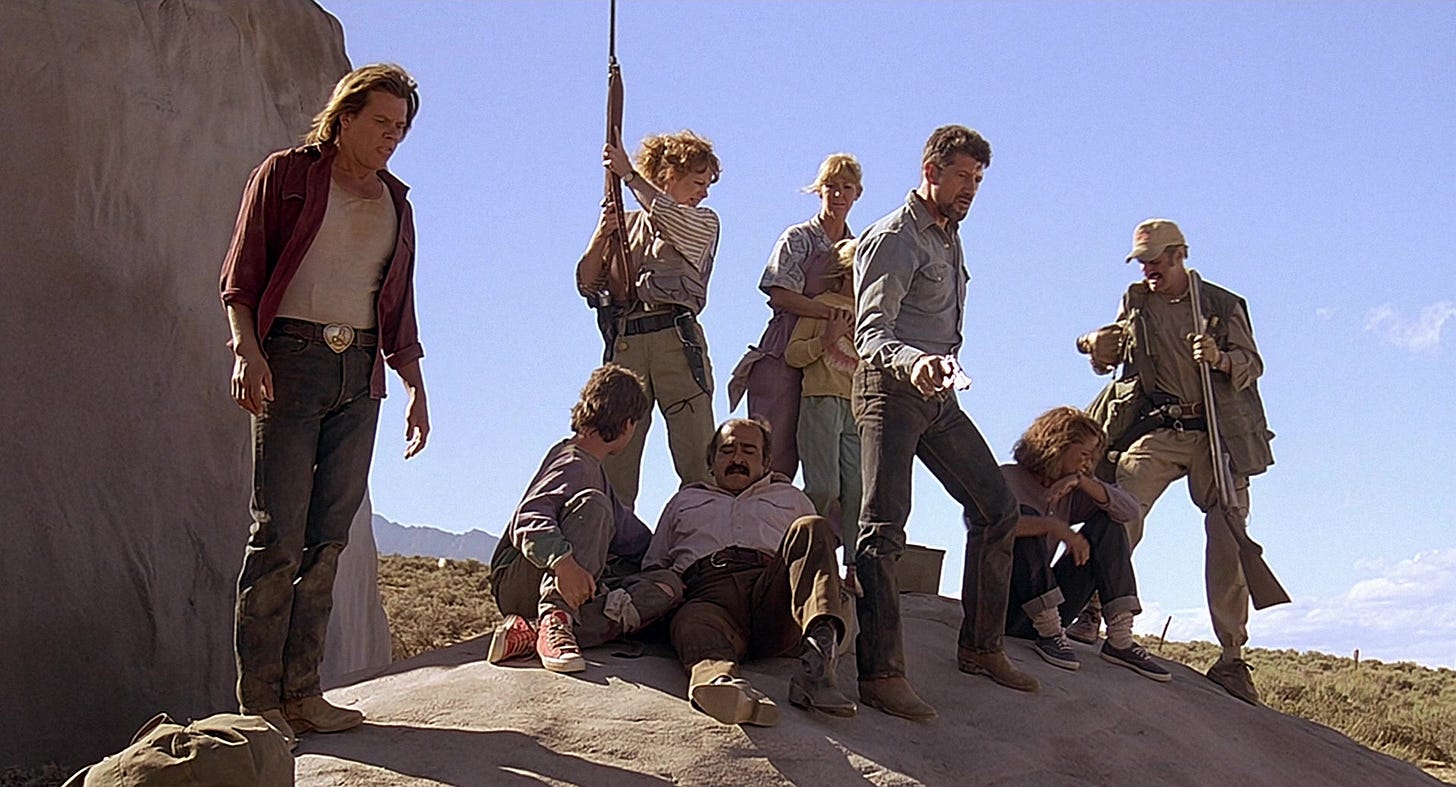
Tremors goes a long way on original thought. Instead of attacking the audience with suspense right away, or previewing the monster, the film proceeds with character and atmosphere right out of a quirky comedy worthy of the title Beneath Perfection. The lawmen or scientists frequently called on to hunt monsters are bypassed for the most part, Finn Carter gamely playing a seismologist from “Mesa State University,” but the script devotes more time to Val and Earl. (Without thinking, name a horror movie with a janitor as protagonist). Handymen without guns or degrees, Val and Earl are blue collar gentlemen in the purest sense, handling the shit jobs–literally–in Perfection. The material organically places the duo in a position to accept the biggest shit job in the history of the town. Character actors as experienced as anyone in blending into an ensemble, Kevin Bacon and Fred Ward summon great chemistry seemingly without effort, while Brent Maddock & S.S. Wilson gave them a lot to work with in their script. The obstacles thrown in Val and Earl’s path–figuring out that the graboids are under the ground, that they track prey by sound, footsteps in particular, and can work in coordinated attack to take down heavy equipment they can’t eat–make the handymen a dynamic and compelling pair.
Reba McEntire, whose presence in movies and television makes it seem like she was a comic actor first and country/ western artist second (her 1986 single “Why Not Tonight” plays over the end credits), further grounds the appeal of Tremors. The filmmakers maintain a delightful rural sensibility–the locations and effort taken to film there worth every penny–and mine the setting for horror, which by the eighties, had taken root in the suburbs. In Tremors, characters live off grid and with no civil authority, depend on each other for survival. Tremors doesn’t conjure subconscious dread the way masterpieces like Jaws (1975), Alien (1979) or The Thing (1982) do, but does appeal to an under served audience who wouldn’t have wanted much to do with Tremors if it was disturbing. In addition to the plucky Second Amendment practitioners played by Michael Gross and McEntire, the tension is softened by Victor Wong, playing a Chinese American merchant who opened a general store in the desert, where competition for goods and services is non-existent. Predating digital effects, the graboids have mass, menace and personality that neo-thrillers like A Quiet Place (2018) and its sequels are completely devoid of, generating their generic monsters with computer software. Considering its producers and director had never made a feature film, Tremors holds up fine against anything else in its genre.
Video rental category: Horror
Special interest: Creature Feature





